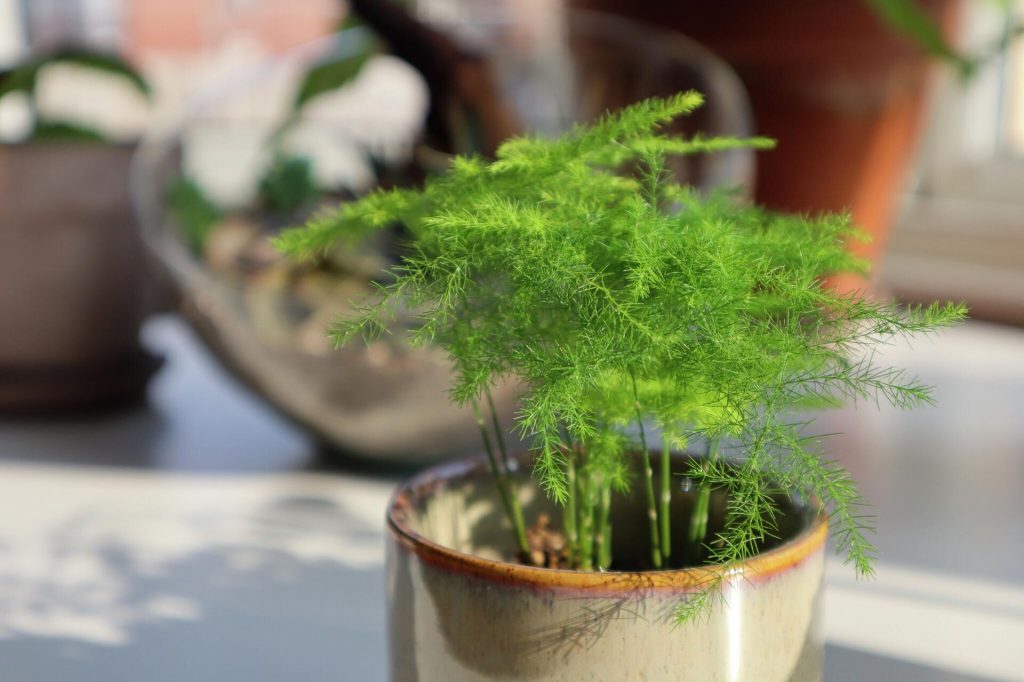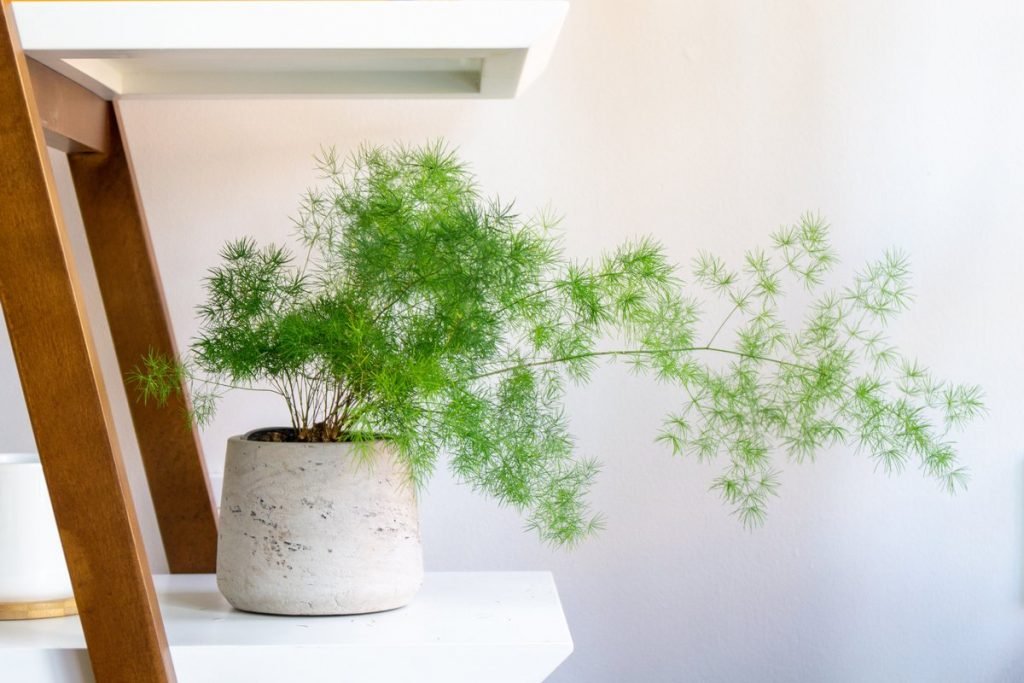Asparagus Fern Overview
In the realm of houseplants, the Asparagus fern stands out as a plant with a distinctive charm. Belonging to the lily family and hailing from the warm climates of southern Africa, the Asparagus fern, or Asparagus densiflorus, is a perennial favorite among plant enthusiasts.
Asparagus Fern Varieties: A Diverse Group
Among the various types of Asparagus ferns, two main varieties often steal the spotlight: Asparagus setaceus, commonly known as lace fern or Asparagus plumosus, and Asparagus densiflorus, referred to as foxtail fern, emerald fern, or plume asparagus. While both varieties boast airy, fern-like foliage, they each have distinct characteristics that set them apart.
- Asparagus setaceus: Known for its fine, feathery leaves, this variety resembles a traditional fern but is much more delicate.
- Asparagus densiflorus: This type is characterized by denser, bushier foliage, often resembling a foxtail, hence its nickname.

Plant Characteristics
Despite their common name, plant Asparagus ferns are not true ferns. They are, in fact, members of the lily family, which also includes garden asparagus. Their popularity as houseplants stems from their attractive, soft foliage, which adds a touch of greenery and texture to indoor spaces. This evergreen perennial is an ideal plant for hanging baskets.
- Decorative Appeal: Asparagus ferns are particularly appealing when cascading from shelves or hanging planters. They can be effectively grouped with other plants for a lush, decorative effect.
- Flowers and Berries: While they do occasionally produce small white flowers and berries, the primary appeal of these plants lies in their foliage.
Asparagus ferns are versatile and can be grown both indoors and outdoors. They are suitable for cultivation in zones 9 to 11 if planted outside but also make excellent houseplants.
- Botanical Classification: Asparagus ferns fall under the Asparagus genus, with A. densiflorus and A. aethiopicus being among the most common species.
- Not True Ferns: Despite their common name, they are warm-weather perennials related to garden asparagus, not true ferns.
- Growing Zones: Typically, they are grown outdoors in zones 9 to 11 but have gained popularity as houseplants due to their attractive appearance and adaptability.
| Feature | Details |
|---|---|
| Common Name | Asparagus Fern |
| Nicknames | Foxtail Fern, Plumosa Fern, Sprengeri Fern |
| Botanical Name | Asparagus setaceus, Asparagus aethiopicus, Asparagus densiflorus |
| Family | Asparagaceae |
| Plant Type | Perennial, Fern-like |
| Mature Size | 2-3 feet tall and wide |
| Sun Exposure | Partial shade to full sun |
| Bloom Time | Summer |
| Flower Color | Small, white or pinkish-white |
| Hardiness Zones | 9-11 |
| Native Area | South Africa |
Toxicity
When it comes to the safety of Asparagus Ferns in a household with pets and children, it’s important to note their level of toxicity. These plants are considered mildly toxic to humans and moderately toxic to cats and dogs.
If ingested, they can cause gastrointestinal discomfort and other symptoms, making it crucial to place them out of reach of curious pets and young children.
Asparagus Fern Care Guide
Light
Asparagus ferns, including the popular varieties Asparagus setaceus (lace fern) and Asparagus densiflorus (foxtail fern), thrive in bright, indirect light. They are perfect for locations where they can receive filtered sunlight, as direct sunlight can scorch their leaves.
- Indoor Placement: A spot near a window with sheer curtains would be ideal, providing ample light without exposing the plant to harsh rays.
- Outdoor Cultivation: If you’re growing them outdoors, partial shade is preferable to protect them from the midday sun.
Water
The watering needs of Asparagus ferns vary with the seasons. In spring and summer, when the plant is actively growing, the compost should be kept moist.
- Spring and Summer: Water the plant regularly, ensuring that the soil stays consistently moist but not waterlogged.
- Autumn and Winter: Reduce watering during these seasons. Allow the topsoil to dry out slightly between waterings.
Regular misting or placing the plant in a humidity tray can also help maintain the required moisture levels, particularly for indoor plants.
Soil
Asparagus ferns do best in soil-based compost that provides proper drainage. A well-drained potting mix is essential to prevent waterlogging, which can lead to root rot.
- Soil Type: Slightly acidic soil with good drainage is ideal for these plants.
- Potting: Ensure the pot has adequate drainage holes. You can add perlite or coarse sand to improve soil aeration and drainage.
Temperature and Humidity
Asparagus ferns prefer a stable environment with a minimum temperature of around 13°C (55°F). They should be kept away from draughts and radiators to prevent sudden temperature fluctuations.
- Temperature Range: Maintaining a temperature around 70°F is ideal for these plants.
- Humidity: These ferns benefit from high humidity levels. Regular misting, using a pebble tray, or grouping plants can help achieve this.
Fertilizer
Feeding your Asparagus ferns is crucial for their growth and health. During the growing seasons of spring and summer, a monthly application of liquid fertilizer will provide the necessary nutrients.
- Feeding Schedule: Use a balanced, water-soluble fertilizer monthly in spring and summer.
- Concentration: It’s advisable to dilute the fertilizer to half the recommended strength to avoid overfeeding.
With these care tips, you can ensure your Asparagus ferns stay healthy and vibrant. Remember, each plant is unique and may require slight adjustments in care based on your home environment.

Asparagus Fern Growing Guide
How to Propagate
Propagation of Asparagus Ferns, particularly varieties like ‘Myeri’, ‘Sprengeri’, ‘Sprengeri Compacta’, and ‘Nana’, can be an enjoyable and rewarding experience.
- Propagation Through Seeds: The berries produced by the Asparagus Fern contain seeds that can be planted. These berries typically appear after the small white flowers.
- Division During Repotting: Spring is the ideal time for propagation by division. When repotting, carefully divide the tuberous roots and plant them separately. This method is often more successful and quicker than growing from seeds.
Potting and Repotting
Asparagus Ferns are known for their fast growth, necessitating regular repotting.
- Choosing the Right Soil: Use loose, well-drained potting soil to ensure healthy growth. The soil should allow for adequate drainage while retaining enough moisture to keep the roots hydrated.
- When to Repot: Repotting every couple of years, particularly in spring, is recommended. This not only refreshes the soil but also provides the plant with more room to grow.
- Repotting Process: Gently remove the plant from its current pot, detangle the roots if necessary, and place it in a slightly larger pot with fresh soil.
Pruning
Pruning is an essential aspect of maintaining your Asparagus Fern.
- Why Prune: These ferns are fast growers, and pruning helps in maintaining their shape and size. It also rejuvenates the plant, encouraging fresh, healthy growth.
- Pruning Technique: Use clean, sharp shears to cut at the base of the unwanted stems. This method helps to keep the plant looking tidy and can also prevent it from becoming too leggy.
Overwintering
For gardeners in cooler climates, overwintering Asparagus Ferns is crucial.
- Indoor Transition: If temperatures in your area drop below 55°F, it’s time to bring your potted Asparagus Ferns indoors.
- Indoor Care During Winter: Place them in a location where they can receive bright, indirect light. Reduce watering during this time, but ensure the plant doesn’t dry out completely.
Pests and Plant Diseases
Asparagus Ferns, with their delicate foliage and unique appearance, can sometimes face challenges from pests and diseases. Understanding these issues and knowing how to effectively address them is crucial for maintaining the health and beauty of your plants.
Common Pests
Asparagus Ferns are susceptible to a few common pests that can affect their overall health and appearance.
- Spider Mites: These tiny pests can cause significant damage by feeding on the plant’s sap, leading to the yellowing and browning of leaves. Spider mites thrive in dry conditions, so increasing humidity can help prevent infestations. If you notice fine webs or small speckles on the leaves, it’s a sign of spider mites. Treat with insecticidal soap or neem oil, applying it thoroughly to the leaves, especially the undersides.
- Aphids and Mealybugs: These pests can also be problematic, sucking the sap from the fern and weakening it. Look out for sticky residue or cottony substances on the plant. Insecticidal soap is an effective treatment against these pests as well.
Overwatering and Root Rot
One of the most common issues with Asparagus Ferns is root rot, usually caused by overwatering. The plant prefers its soil to be moist but not waterlogged.
- Prevention: Ensure your potting mix is well-draining and that your pots have drainage holes. Always check the top inch of soil for dryness before watering again.
- Treatment: If you suspect root rot, remove the plant from its pot and inspect the roots. Trim away any soft, brown roots and repot the plant in fresh soil.
Common Problems
Yellowing Fronds
- Causes: Yellow leaves can indicate several problems, including pests, over-fertilization, or inadequate light.
- Solutions: Check for pests and treat them as necessary. If over-fertilization is the issue, reduce the frequency and strength of your fertilizer. Adjust the plant’s position to ensure it receives the right amount of light.
Pale Fronds
- Causes: Pale fronds may be a sign that the plant is not receiving enough light.
- Solutions: Move your Asparagus Fern to a brighter location where it can receive bright, indirect sunlight.
Browning Leaves
- Causes: Browning leaves often result from dry air or under-watering.
- Solutions: Increase humidity around the plant through misting or using a humidity tray. Ensure that you are watering the plant regularly, allowing the soil to dry slightly between waterings.
Dropping Leaves
- Causes: This can occur due to inconsistent watering – either too much or too little.
- Solutions: Establish a more consistent watering schedule. The soil should be allowed to dry out slightly between waterings, but not completely.
By being vigilant and responsive to these common issues, you can keep your Asparagus Fern healthy and thriving. Regularly check your plant for signs of distress and adjust your care routine accordingly.

Asparagus Fern FAQ
How to Propagate Asparagus setaceus (Plumosa Fern)?
To propagate Asparagus setaceus, commonly known as Plumosa Fern:
- Division: The most effective way is by dividing mature plants during repotting. Carefully separate the root ball into smaller sections, each with its own set of roots and foliage.
- Seeds: You can also grow them from seeds, although this method takes longer. Scarify the seeds and soak in water before planting to encourage germination.
Why is My Foxtail Fern Turning Yellow?
Foxtail Fern, or Asparagus densiflorus, turning yellow can be due to several reasons:
- Overwatering: The most common cause is overwatering or poor drainage leading to root rot. Ensure the soil dries out between waterings.
- Underwatering: If the plant isn’t receiving enough water, the leaves will turn yellow. Check the soil moisture and adjust your watering schedule accordingly.
- Nutrient Deficiency: Lack of proper nutrients can also cause yellowing. Fertilize the plant during its active growing period.
When to Cut Plumosa Fern?
For Plumosa Fern (Asparagus setaceus):
- Pruning: Trim the fern when you notice the stems becoming too long or remove any brown or dead foliage. Use sharp shears and wear gloves to protect from the thorny stems.
- Timing: Late winter or early spring, before new growth starts, is the best time for pruning.
How Often to Water Asparagus Fern?
Watering frequency for Asparagus ferns:
- General Rule: Water when the top inch of the soil feels dry. This could be once a week or more, depending on the environmental conditions.
- Seasonal Adjustments: Reduce watering in the winter when the plant’s growth slows down.
Can Sprengeri Fern Take Full Sun?
Sprengeri Fern, also known as Asparagus aethiopicus:
- Sun Exposure: It prefers bright, indirect light. While it can tolerate some direct sunlight, too much can scorch the leaves, turning them brown.
- Best Practice: Place it in a spot where it gets filtered sunlight or partial shade, especially during the hottest part of the day.
How to Grow Asparagus Fern Indoors?
Yes, Asparagus ferns are excellent houseplants. They adapt well to indoor conditions, provided they get enough light and proper care for asparagus. Make sure to place them near a window where they can receive bright, indirect light.
How Do You Make Asparagus setaceus Bushy Indoors?
To encourage a bushy growth in Asparagus setaceus indoors:
- Regular Pruning: Trim the plant near the base to stimulate new growth. This will encourage the plant to become fuller and bushier.
- Adequate Light: Ensure it gets enough light. Place it in a location with bright, indirect light.
- Proper Fertilization: Regularly fertilize during the growing season to promote healthy, vigorous growth.
How Do You Revive a Yellow Sprengeri Fern?
To revive a yellowing Sprengeri Fern:
- Adjust Watering: Ensure you’re not over or under-watering. Let the soil dry out slightly between waterings.
- Check Light: Move the plant to a location with bright, indirect light if it’s not getting enough light.
- Feed the Plant: Fertilize with a balanced fertilizer during its growing season.
How Do You Make Plumosa Fern Thrive?
For Plumosa Fern to thrive:
- Ideal Conditions: Provide bright, indirect light, consistent moisture without waterlogging, and fertilize regularly.
- Humidity: These ferns appreciate higher humidity. Mist the plant daily or place it on a pebble tray.
What is the Best Time to Transplant Asparagus?
The best time to transplant Asparagus ferns is in the spring, just before they start their active growing period. This gives the plant time to establish itself in its new location before the growing season.
Can I Grow Foxtail Fern from Cuttings?
Foxtail Fern, or Asparagus densiflorus, is typically propagated through division rather than cuttings. Divide the roots and replant in well-drained potting soil to propagate.
Do Asparagus Ferns Have Berries?
Yes, Asparagus Fern, specifically the species commonly known as Asparagus setaceus, can produce berries. The berries are typically small and round, starting green and turning to red berries or black hue when ripe. Inside each berry are seeds that can be used for propagation.
However, it’s important to note that while these berries may look attractive, they are toxic if ingested, especially to pets and small children.
Introduction
Nicki Mann, based in Portland, Oregon, is a good writer and houseplant enthusiast. With her background in environmental science, Nicki specializes in indoor gardening, focusing on sustainable and organic practices.
Experience
Her interest in houseplants began in her mid-twenties, leading to a career writing articles about indoor plant care and eco-friendly gardening for various websites.
Education
Nicki holds a Bachelor of Science in Environmental Studies from the University of Oregon, which underpins her approach to indoor gardening. She continually enhances her knowledge through horticulture and environmental sustainability workshops.
Personal Life
Nicki, an avid nature lover, enjoys exploring the Pacific Northwest's trails. She's active in community gardening and lives with her two rescue cats, who share her interest in her growing collection of houseplants.


